1995 GMC SIERRA transmission
[x] Cancel search: transmissionPage 92 of 488
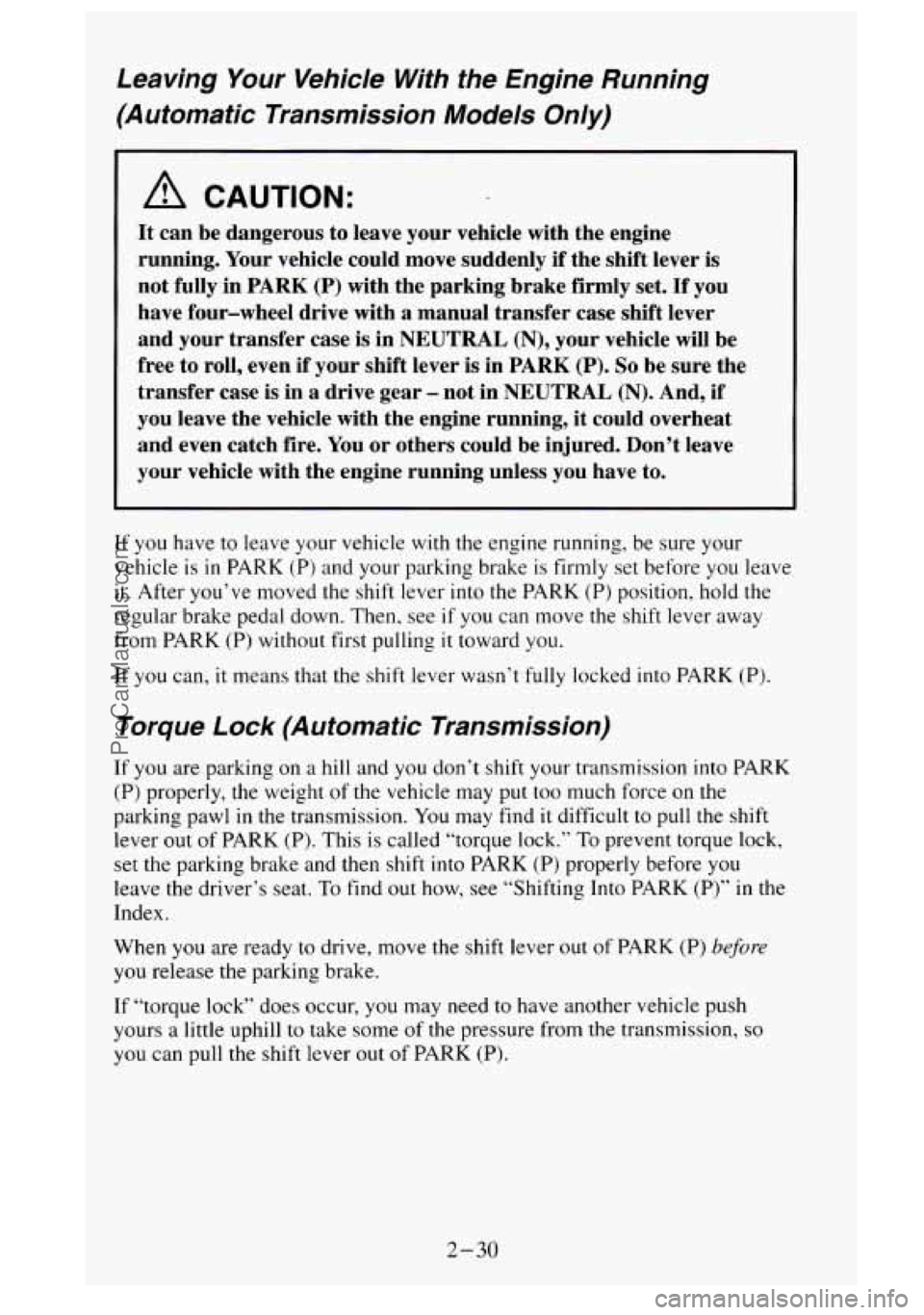
Leaving Your Vehicle With the Engine Running
(Automatic Transmission Models
Only)
A CAUTION:
It can be dangerous to leave your vehicle with the engine
running. Your vehicle could move suddenly if the shift lever
is
not fully in PARK (P) with the parking brake firmly set. If you
have four-wheel drive with a manual transfer case shift lever
and your transfer case is in
NEUTRAL (N), your vehicle will be
free to roll, even if your shift lever is in PARK
(P). So be sure the
transfer case
is in a drive gear - not in NEUTRAL (N). And, if
you leave the vehicle with the engine running, it could overheat
and even catch fire.
You or others could be injured. Don’t leave
your vehicle with the engine running unless you have to.
If you have to leave your vehicle with the engine running, be sure your
vehicle is in PARK (P) and your parking brake is firmly set before you leave
it. After you’ve moved the shift lever into the PARK (P) position, hold the
regular brake pedal down. Then. see
if you can move the shift lever away
from PARK (P) without first pulling
it toward you.
If
you can, it means that the shift lever wasn’t fully locked into PARK (P).
Torque Lock (Automatic Transmission)
If you are parking on a hill and you don’t shift your transmission into PARK
(P) properly, the weight of the vehicle may put too much force on the
parking pawl in the transmission.
You may find it difficult to pull the shift
lever out of PARK (P). This is called “torque lock.” To prevent torque lock,
set the parking brake and then shift into PARK (P) properly before you
leave the driver’s seat.
To find out how, see “Shifting Into PARK (P)” in the
Index.
When you are ready to drive, move the shift lever out
of PARK (P) before
you release the parking brake.
If “torque lock” does occur, you may need to have another vehicle push
yours
a little uphill to take some of the pressure from the transmission, so
you can pull the shift lever out of PARK (P).
2-30
ProCarManuals.com
Page 93 of 488
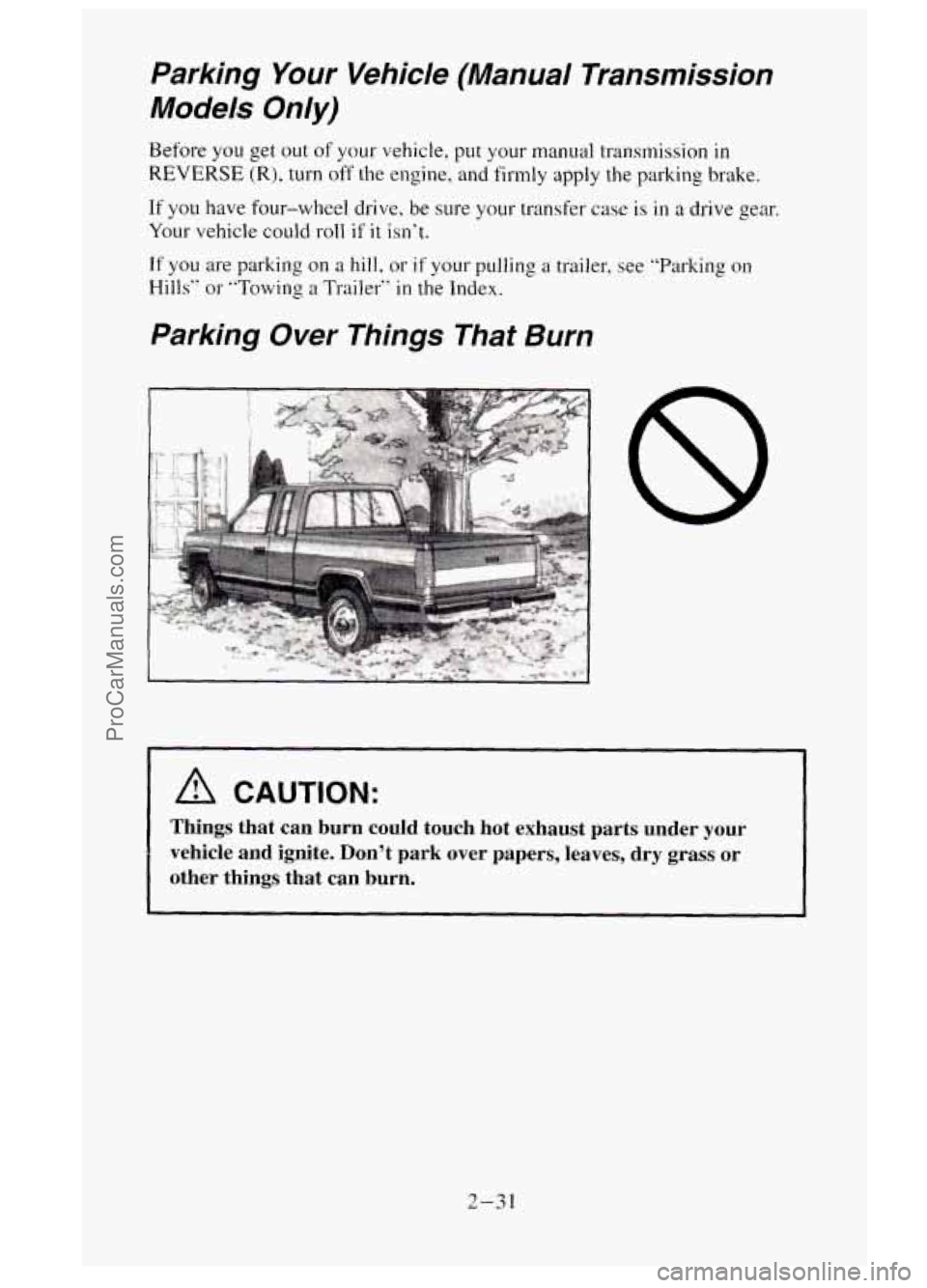
Parking Your Vehicle (Manual Transmission
Models Only)
Before you get out of your vehicle, put your manual transmission in
REVERSE (R), turn off the engine, and firmly apply the parking brake.
If you have four-wheel drive, be sure your transfer case is in a drive gear.
Your vehicle could roll if it isn't.
If you are parking on
a hill, or if your pulling a trailer, see "Parking on
Hills" or '"Towing a Trailer" in the Index.
Parking Over Things That Burn
1 A CAUTION:
Things that can burn could touch hot exhaust parts under your \
vehicle and ignite. Don't park over papers, leaves, dry grass
or
other things that can burn.
2-31
ProCarManuals.com
Page 94 of 488
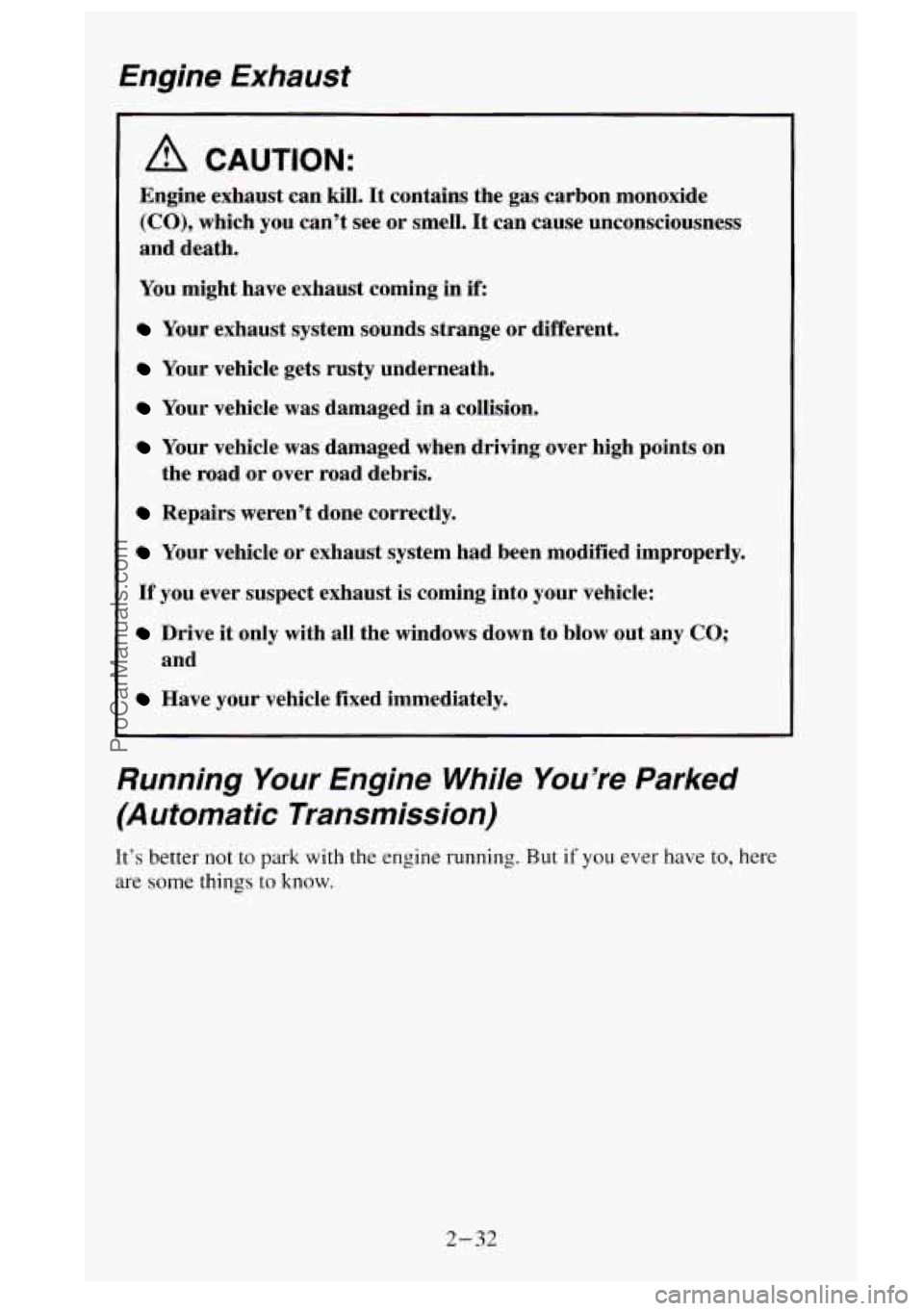
Engine Exhaust
A CAUTION:
Engine exhaust can kill. It contains the gas carbon monoxide
(CO), which you can’t see or smell. It can cause unconsciousness
and death.
You might have exhaust coming in if:
Your exhaust system sounds strange or different.
Your vehicle gets rusty underneath.
Your vehicle was damaged in a collision.
Your vehicle was damaged when driving over high points on
the road or over road debris.
Repairs weren’t done correctly.
Your vehicle or exhaust system had been modified improperly.
If you ever suspect exhaust is coming into your vehicle:
Drive it only with all the windows down to blow out any CO;
and
Have your vehicle fixed immediately.
Running Your Engine While You’re Parked
(Automatic Transmission)
It’s better not to park with the engine running. But if you ever have to, here
are
some things to know.
2-32
ProCarManuals.com
Page 97 of 488
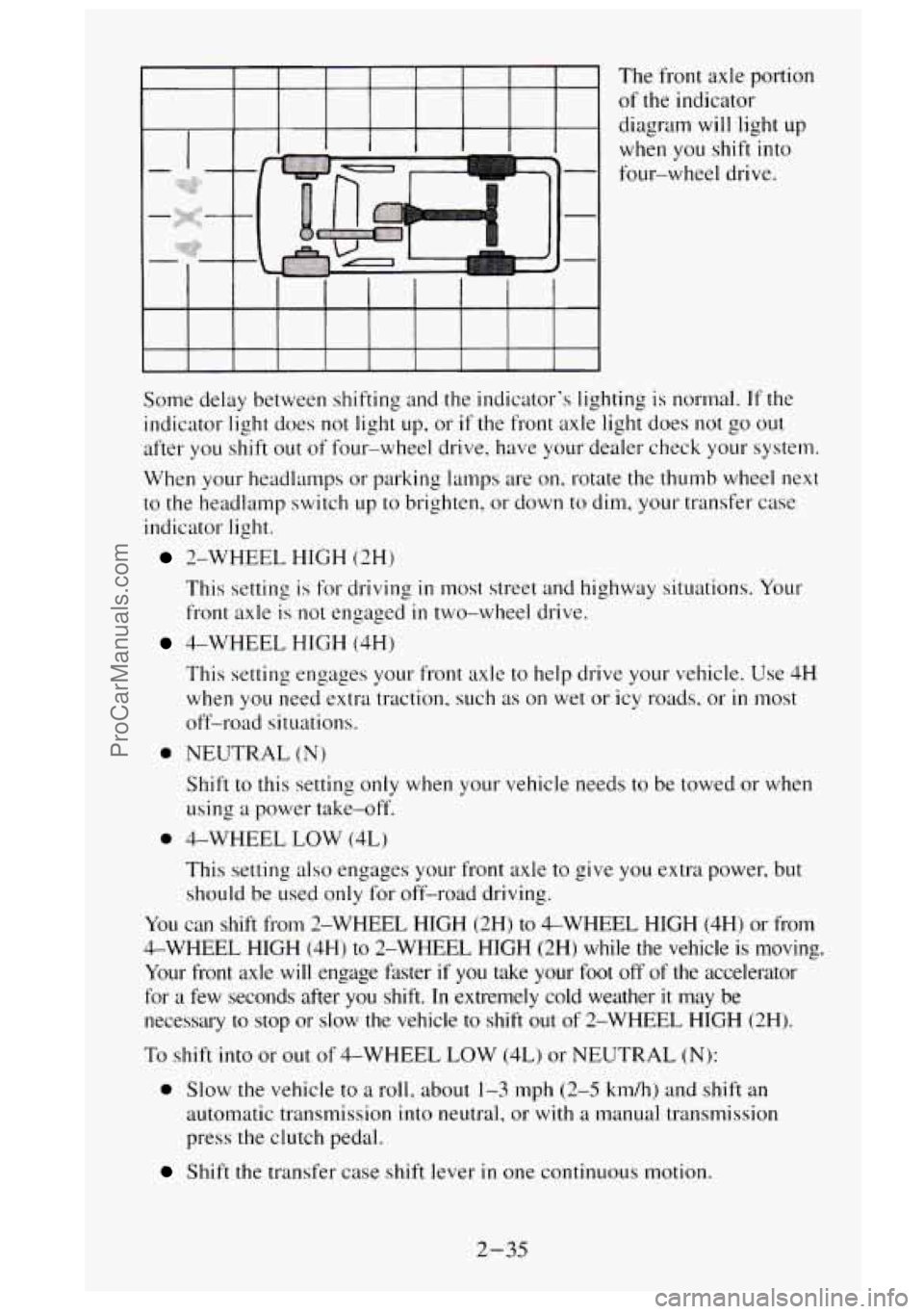
The from axle portion
of the indicator
diagram will light
up
when you shift into
four-wheel drive.
Some delay between shifting and the indicator's lighting is normal.
If the
indicator light does not light
up, or if the front axle light does not go out
after you shift out of four-wheel drive. have your dealer check your system.
When your headlamps or parking lamps are
on, rotate the thumb wheel next
to the headlamp switch up to brighten, or down to dim, your transfer case
indicator light.
2-WHEEL HIGH (2H)
This setting is for driving
in most street and highway situations. Your
front axle is not engaged
in two-wheel drive.
4-WHEEL HIGH (4H)
This setting engages your front axle to help drive your vehicle. Use
4H
when you need extra traction, such as on wet or icy roads. or in most
off-road situations.
0 NEUTRAL (N)
Shift to this setting only when your vehicle needs to be towed or when
using
a power take-off.
0 4-WHEEL LOW (4L)
This setting also engages your front axle to give you extra power, but
should be used only for off-road driving.
You can shift from 2-WHEEL HIGH (2H)
to &WHEEL HIGH (4H) or from
4-WHEEL HIGH (4H) to 2-WHEEL HIGH (2Hj while the vehicle is moving.
Your front axle
will engage faster if you take your foot off of the accelerator
for a few seconds after you shift.
In extremely cold weather it may be
necessary
to stop or slow the vehicle to shift out of 2-WHEEL HIGH (2H).
To shift
into or out of 4-WHEEL LOW (4L) or NEUTRAL (N):
0 Slow the vehicle to a roll. about 1-3 mph (2-5 km/h) and shift an
automatic transmission into neutral,
or with a manual transmission
press the clutch pedal.
Shift the transfer case shift lever in one continuous motion.
2-35
ProCarManuals.com
Page 140 of 488
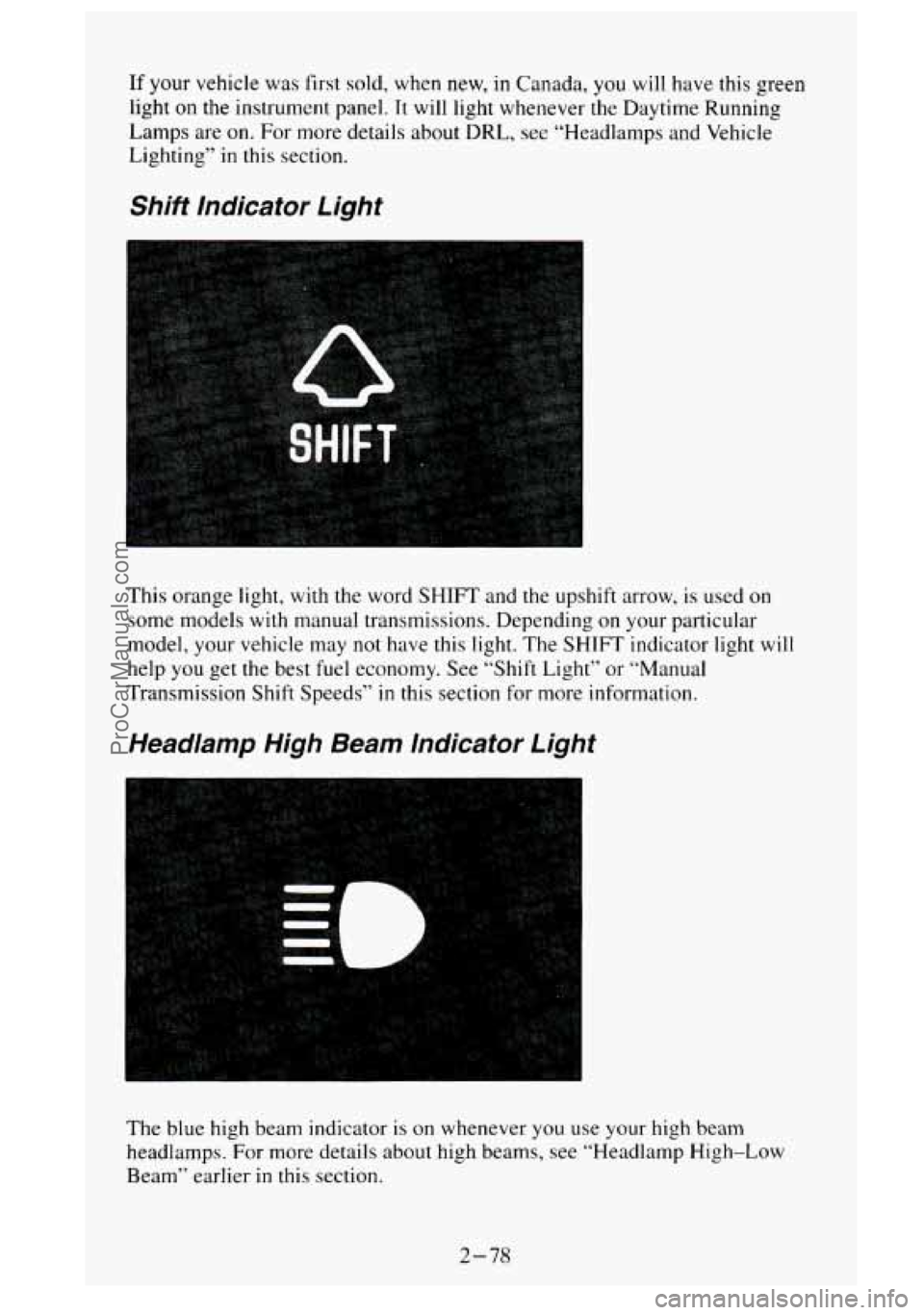
If your vehicle was first sold, when new, in Canada, you will have this green
light
on the instrument panel. It will light whenever the Daytime Running
Lamps are on. For more details about DRL, see “Headlamps and Vehicle
Lighting”
in this section.
Shift Indicator Light
e
This orange light, with the word SHIFT and the upshift arrow, is used on
some models with manual transmissions. Depending on your particular
model, your vehicle may not have this light. The SHIFT indicator light will
help you get
the best fuel economy. See “Shift Light” or “Manual
Transmission Shift Speeds”
in this section for more information.
Headlamp High Beam Indicator Light
The blue high beam indicator is on whenever you use your high beam
headlamps. For more details about high beams, see “Headlamp High-Low
Beam” earlier
in this section.
2-78
ProCarManuals.com
Page 191 of 488
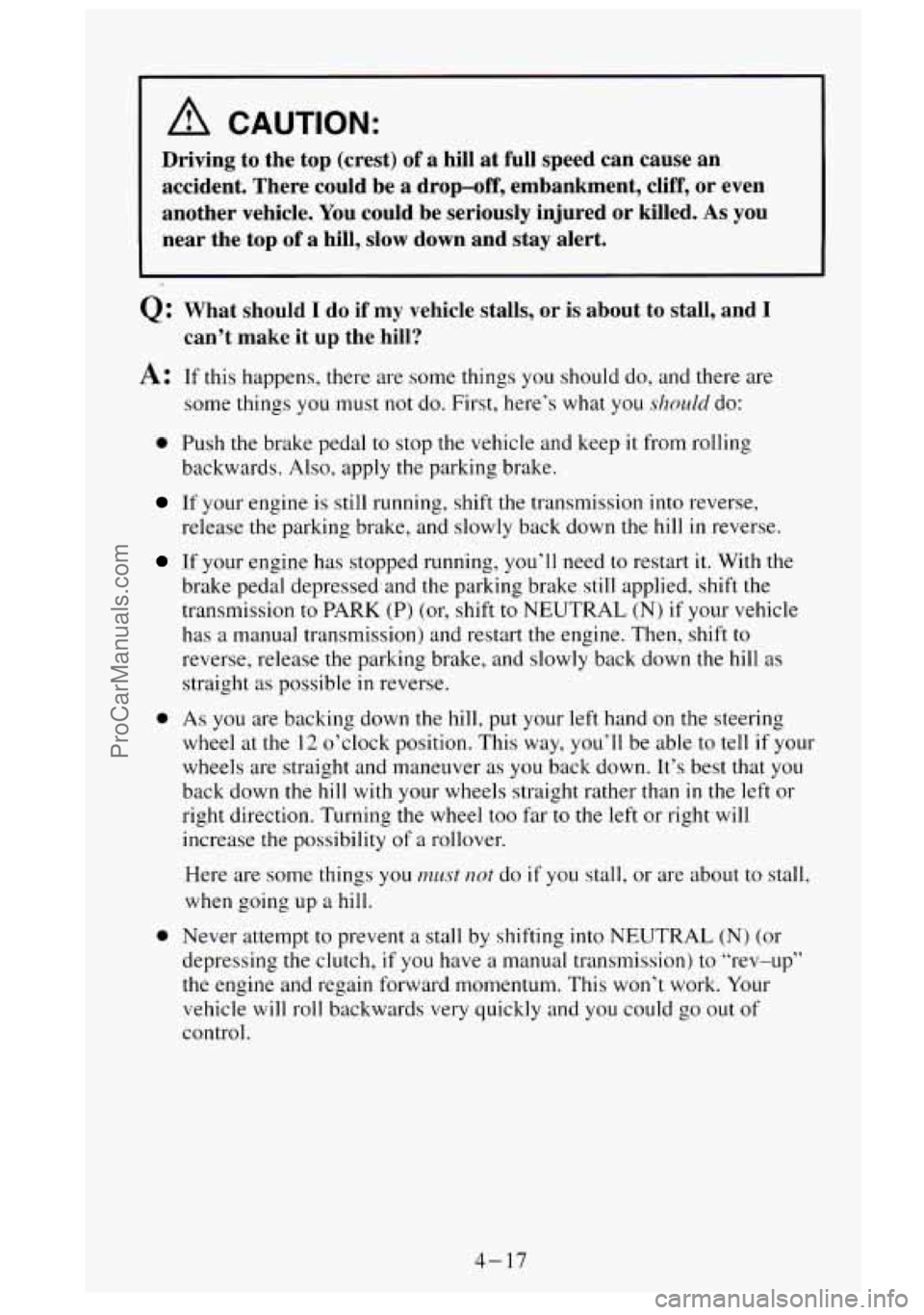
A CAUTION:
Driving to the top (crest) of a hill at full speed can cause an
accident. There could be a drop-off, embankment, cliff, or even
another vehicle. You could be seriously injured
or killed. As you
near the top
of a hill, slow down and stay alert.
Q: What should I do if my vehicle stalls, or is about to stall, and I
A: If this happens, there are some things you should do, and there are
some things you must not do. First, here’s what you
shoclld do:
can’t make it up the hill?
0 Push the brake pedal to stop the vehicle and keep it from rolling
backwards. Also, apply the parking brake.
If your engine is still running, shift the transmission into reverse,
release the parking brake, and slowly back down the
hill in reverse.
If your engine has stopped running, you’ll need to restart it. With the
brake pedal depressed and the parking brake still applied, shift the
transmission to PARK (P) (or, shift to NEUTRAL
(N) if your vehicle
has a manual transmission) and restart the engine. Then, shift
to
reverse, release the parking brake, and slowly back down the hill as
straight
as possible in reverse.
0 As you are backing down the hill, put your left hand on the steering
wheel at the
12 o’clock position. This way, you’ll be able to tell if your
wheels are straight and maneuver
as you back down. It’s best that you
back down the hill with your wheels straight rather than in the left or
right direction. Turning the
wheel too far to the left or right will
increase the possibility
of a rollover.
Here are some things you
must mt do if you stall, or are about to stall,
when going
up a hill.
0 Never attempt to prevent a stall by shifting into NEUTRAL (N) (or
depressing the clutch,
if you have a manual transmission) to ”rev-up”
the engine and regain forward momentum. This won’t work. Your
vehicle will roll backwards very quickly and
you could go out of
control.
4-’17
ProCarManuals.com
Page 192 of 488
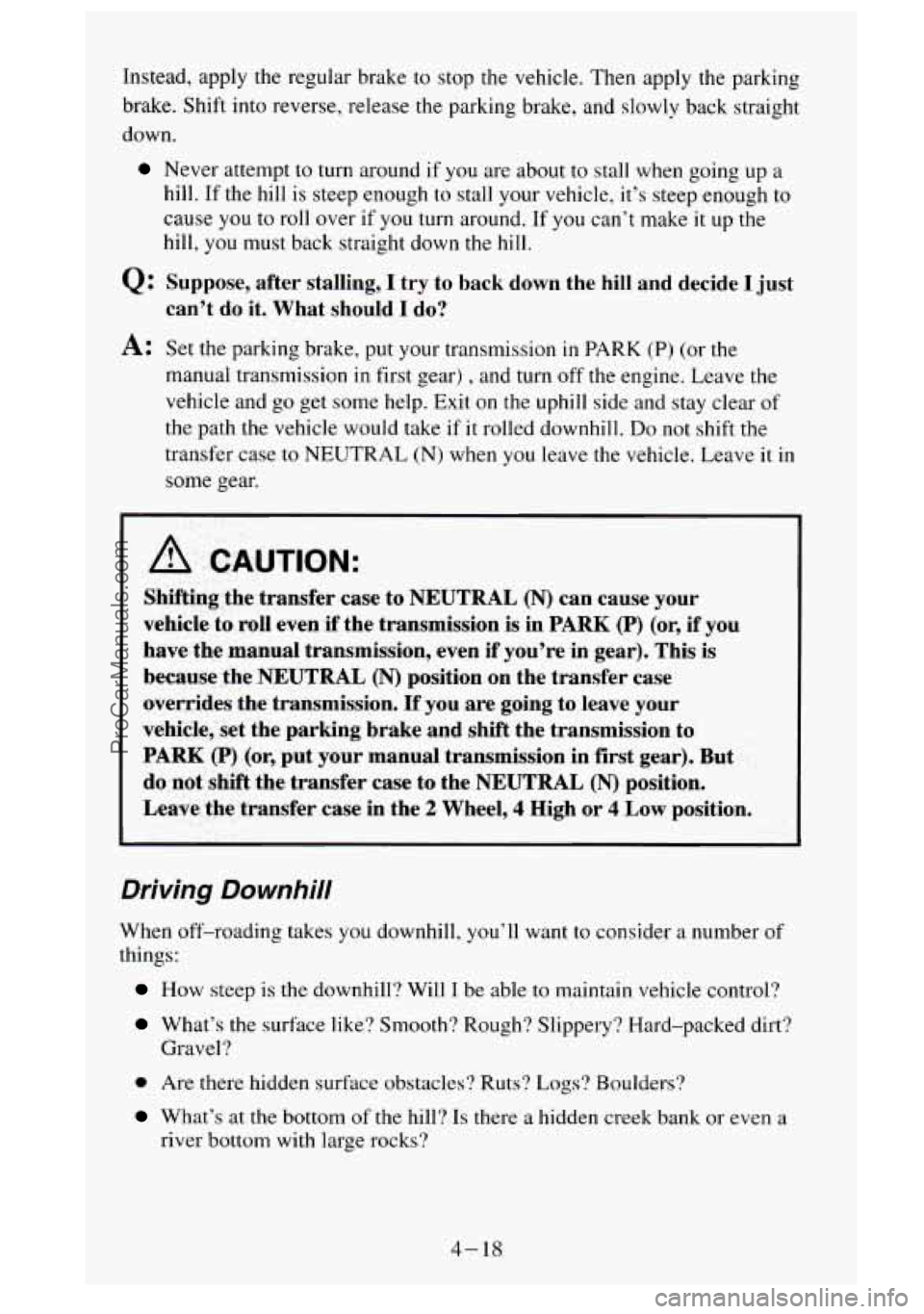
Instead, apply the regular brake to stop the vehicle. Then apply the parking
brake. Shift into reverse, release
the parking brake, and slowly back straight
down.
Never attempt to turn around if you are about to stall when going up a
hill.
If the hill is steep enough to stall your vehicle, it’s steep enough to
cause you to roll over if
you turn around. If you can’t make it up the
hill, you must back straight down the hill.
Q: Suppose, after stalling, I try to back down the hill and decide I just
A: Set the parking brake, put your transmission in PARK (P) (or the
can’t do it. What should I do?
manual transmission in first gear) , and turn off the engine. Leave the
vehicle and go get some help. Exit on the uphill side and stay clear
of
the path the vehicle would take if it rolled downhill. Do not shift the
transfer case
to NEUTRAL (N) when you leave the vehicle. Leave it in
some gear,
I A CAUTION:
Shifting the transfer case to NEUTRAL (N) can cause your
vehicle to roll even
if the transmission is in PARK (P) (or, if you
have the manual transmission, even if you’re in gear), This is
because the
NEUTRAL (N) position on the transfer case
overrides the transmission.
If you are going to leave your
vehicle, set the parking brake and shift the transmission to
PARK (P) (or, put your manual transmission in first gear). But
do not shift the transfer case to the NEUTRAL (N) position.
Leave the transfer case in the
2 Wheel, 4 High or 4 Low position.
Driving Downhill
When off-roading takes you downhill, you’ll want to consider a number of
things:
How steep is the downhill? Will I be able to maintain vehicle control?
What’s the surfxe like? Smooth? Rough? Slippery? Hard-packed dirt?
Gravel?
0 Are there hidden surface obstacles? Ruts? Logs? Boulders?
What’s at the bottom of the hill? Is there a hidden creek bank or even a
river bottom with large rocks?
4-18
ProCarManuals.com
Page 193 of 488
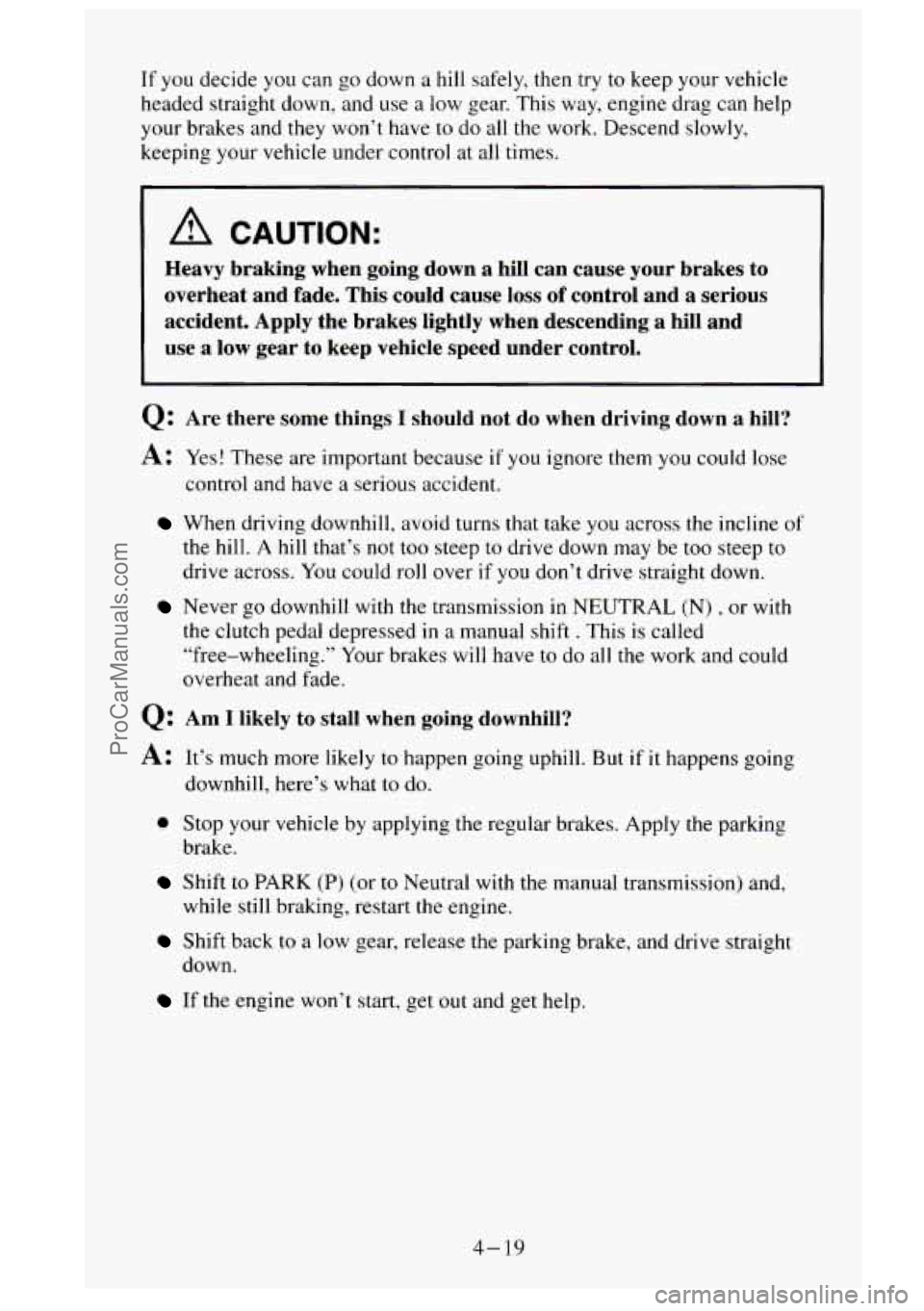
If you decide you can go down a hill safely, then try to keep your vehicle
headed straight down, and use a low gear. This way, engine drag can help
your brakes and they won’t have to do all
the work. Descend slowly,
keeping your vehicle under control at all times.
A CAUTION:
Heavy braking when going down a hill can cause your brakes to
overheat and fade. This could cause
loss of control and a serious
accident. Apply the brakes lightly when descending
a hill and
use a low gear to keep vehicle speed under control.
Q: Are there some things I should not do when driving down a hill?
A: Yes! These are important because if you ignore them you could lose
control and have a serious accident.
When driving downhill, avoid turns that take you across the incline of
the hill. A hill that’s not too steep to drive down may be too steep to
drive across.
You could roll over if you don’t drive straight down.
Never go downhill with the transmission in NEUTRAL (N) , or with
the clutch pedal depressed in a manual shift
. This is called
“free-wheeling.” Your brakes will have to do all the work and could
overheat and fade.
Q: Am I likely to stall when going downhill?
A: It’s much more likely to happen going uphill. But if it happens going
downhill, here’s what
to do.
0 Stop your vehicle by applying the regular brakes. Apply the parking
brake.
Shift to PARK (P) (or to Neutral with the manual transmission) and,
while still braking, restart the engine.
down.
Shift back to a low gear, release the parking brake, and drive straight
If the engine won’t start, get out and get help.
4- 19
ProCarManuals.com